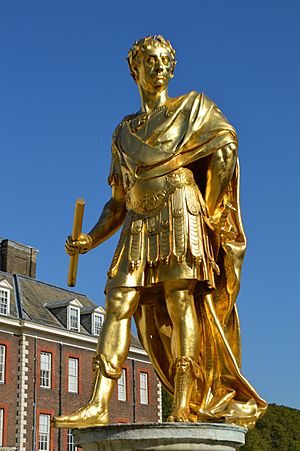Statue of Charles II, Royal Hospital Chelsea facts for kids
Quick facts for kids Statue of Charles II |
|
|---|---|
 |
|
| Artist | Grinling Gibbons |
| Completion date | c. 1680 |
| Type | Statue |
| Medium | Brass |
| Subject | Charles II of England |
| Dimensions | 1.55 m × 1.18 m (5.1 ft × 3.9 ft) |
| Location | |
|
Listed Building – Grade I
|
|
| Official name | Statue of Charles II in centre of middle courtyard in main buildings, Royal Hospital |
| Designated | 5 April 1969 |
| Reference no. | 1226477 |
The statue of Charles II is a famous sculpture located at the Royal Hospital in London. It was created by a talented artist named Grinling Gibbons around 1680-1682. King Charles II started the Royal Hospital in 1682 to be a home for soldiers who had retired from the army. This statue is very important and is protected as a Grade I listed structure.
History of the Statue
King Charles II founded the Royal Hospital in 1682. He wanted to care for soldiers who were old or had been hurt in wars. The idea for this hospital came from a similar place in Paris, France. That hospital was called the Hôtel des Invalides.
The famous architect Christopher Wren was chosen to design the Royal Hospital. Construction of the hospital took place from 1682 to 1691. The statue of King Charles was ordered by Tobias Rustat. He was a member of the king's court.
Grinling Gibbons designed the statue around 1682. He was paid £500 for his work. The statue was not always at the Royal Hospital. It was moved there after King Charles died in 1685.
Every year, on May 29th, there is a special day called Oak Apple Day. This day celebrates the return of the monarchy in 1660, known as the Restoration. On this day, the statue is decorated with oak leaves.
What the Statue Looks Like
The statue is made of brass. It was originally covered in a thin layer of gold, called gilding. It was re-gilded in 2002 to celebrate the Golden Jubilee of Queen Elizabeth II. This marked 50 years of Queen Elizabeth II being on the throne.
The statue shows King Charles II dressed like a general from ancient Rome. It stands about 7.6 feet (2.3 meters) tall. The statue rests on a base made of marble.
In 1969, the statue was named a Grade I listed structure. This is the highest level of protection given to buildings and structures in the United Kingdom. It means the statue is considered to be of "exceptional interest."

